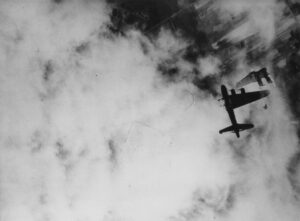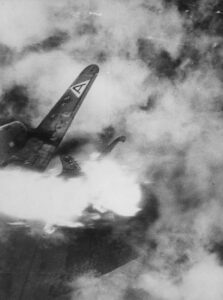
8 April 1945 – Wee Willie, a Flying Fortress heavy bomber, left its base at Air Force Station 121 (RAF Bassingbourne, Cambridgeshire, England), on its 129th combat mission over western Europe. The aircraft commander was 1st Lieutenant Robert E. Fuller, U.S. Army Air Forces.
Wee Willie was a B-17G-15-BO, serial number 42-31333, built by the Boeing Airplane Company’s Plant 2, Seattle, Washington. It was delivered to the United States Army Air Forces at Cheyenne, Wyoming on 22 October 1943, The identification letters LG W were painted on both sides of its fuselage, and a white triangle with a black letter A on the top of its right wing and both sides of its vertical fin.

On 8 April 1945, the 322nd Bombardment Squadron was part of an attack against the locomotive repair facilities at the railroad marshaling yards in Stendal, Saxony-Anhalt Germany. The squadron was bombing through clouds using H2S ground search radar to identify the target area. Antiaircraft gunfire (flak) was moderate, causing major damage to four B-17s and minor damage to thirteen others. Two bombers from the 91st Bomb Group were lost, including Wee Willie.
The Missing Air Crew Report, MACR 13881, included a statement from a witness:
“We were flying over the target at 20,500 feet [6,248 meters] altitude when I observed aircraft B-17G, 42-31333 to receive a direct flak hit approximately between the bomb bay and #2 engine. The aircraft immediately started into a vertical dive. The fuselage was on fire and when it had dropped approximately 5,000 feet [1,524 meters] the left wing fell off. It continued down and when the fuselage was about 3,000 feet [914.4 meters] from the ground it exploded and then exploded again when it hit the ground. I saw no crew member leave the aircraft or parachutes open.”
The pilot, Lieutenant Fuller, did escape from the doomed bomber. He was captured and spent the remainder of the war as a Prisoner of War. The other eight crew members, however, were killed.
- 1st Lieutenant Robert E. Fuller, O-774609, California. Aircraft Commander/Pilot—Prisoner of War
- 2nd Lieutenant Woodrow A. Lien, O-778858, Montana. Co-pilot—Killed in Action
- Technical Sergeant Francis J. McCarthy, 14148856, Tennessee. Navigator—Killed in Action
- Staff Sergeant Richard D. Proudfit, 14166848, Mississippi. Togglier—Killed in Action
- Staff Sergeant Wylie McNatt, Jr., 38365470, Texas. Flight Engineer/Top Turret Gunner—Killed in Action
- Staff Sergeant William H. Cassiday, 32346219, New York. Ball Turret Gunner—Killed in Action
- Staff Sergeant Ralph J. Leffelman, 19112019, Washington. Radio Operator/Top Gunner—Killed in Action
- Staff Sergeant James D. Houtchens, 37483248, Nebraska. Waist Gunner—Killed in Action
- Sergeant Le Moyne Miller, 33920597, Pennsylvania. Tail Gunner—Killed in Action
Source: ThisDayinAviation by Bryan R. Swopes c. 2019 (excerpted from full article)
